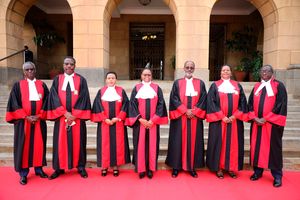
Ngong Station in Kajiado County during the launch of SGR Phase 2A by President Uhuru Kenyatta on October 16, 2019. SGR is one of the projects funded by Chinese loans.
| File | Nation Media GroupBusiness
Premium
Kenya to spend Sh100bn in servicing Chinese loans
What you need to know:
- The repayment is the largest proportion of monies due to a single lender this year.
- The money due to China is 30 per cent of the entire cash that Kenya’s external creditors will receive this year.
Kenya will spend over 100 billion of its Sh3.65 trillion budget to repay the mountain of debt it owes China, underlining the country’s increasingly worrying dependence on loans from the Asian giant.
Data from the Parliamentary Budget Office (PBO), which is mandated to analyse the annual budgets and advise lawmakers accordingly, shows that Nairobi will send Sh119.7 billion, representing 3.2 percent of the total budget, to Beijing.
The repayments are for loans that will mature during the year plus interest, and they represent the largest proportion of monies due to a single lender this year.
The money due to China is also 30 per cent of the entire cash that Kenya’s external creditors will receive this year— dwarfing other bilateral and multilateral lenders such as the World Bank, African Development Bank (ADB), France, Japan and institutional local borrowers.
This comes as Kenya’s debt servicing costs are due to hit Sh1.17 trillion this year up from the Sh958 billion that was expended on the same in 2020.
The spike follows expiry of debt payments that were due last year but were pushed to this year to cushion the economy from the Covid-19 pandemic.
“This increase could be as result of a pile-up of debt repayment deferred in FY 2020/21 by creditors under the Debt Servicing Suspension Initiative (DSSI),” PBO said.
Kenya’s annual debt obligations to China have been steadily rising over the past few years, and moved from Sh83.1 billion in 2019 to Sh95 billion last year before crossing the Sh100-billion mark this year— Sh97.1 billion due to the EXIM Bank of China and Sh22.6 billion to the development Bank of China.
Increasing debt
China is by far Kenya’s largest creditor, with Nairobi’s outstanding bilateral debt grossing Sh757 billion ($7.08 billion) as at December 31 last year, which is 10.3 per cent of Kenya’s stock of public debt, which stood at Sh7.28 trillion at that time.
Kenya’s debt has since increased by Sh432 billion to Sh7.71 trillion, following additional borrowing from the World Bank, the International Monetary Fund (IMF) and a fresh Eurobond issue.
The rising dues to China come even as Treasury last month revealed that the country is betting on the Asian country as primary market for shopping new loans, amid rising spending needs and depressed revenue collection.
In a prospectus intended to appeal to international investors to buy Kenya’s latest Sh108 billion ($1 billion) Eurobond, the Treasury said the two countries’ deep economic ties mean that a strain in China’s economy would inhibit Kenya’s ability to meet its future borrowing needs.
“China is Kenya’s largest creditor and an adverse impact on the Chinese economy may impact the future ability of Kenya to increase its borrowings,” the Treasury said.
Meanwhile, the Eastern and Southern African Trade and Development Bank (TDB) will be the second largest recipient of monies to external creditors, pocketing Sh69.1 billion for its syndicated loan, while the World Bank’s International Development Association (IDA) and Italy will get Sh37.1 billion and Sh19.4 billion, respectively.
Other European lenders— including Germany, France and Spain — will receive Sh6.1 billion, Sh5.4 billion and Sh14.7 billion, respectively, this year, while Japan and the ADB will get Sh11.1 billion and Sh8.9 billion, respectively.
Also, Sh19.8 billion will be used to repay new loans during the current financial year, while other lenders will share out Sh36.6 billion.
Kenya will also pay Sh15.1 billion for its debut $2.75 billion (Sh298 billion at the current exchange rates) Eurobond it took in 2014, which broke the record for the largest debut for an African country into the sovereign bonds market.
Interest on debt
It will pay Sh17.3 billion for the Sh217 billion ($2 billion) Eurobond it floated in 2018, Sh7.2 billion on the third Eurobond issued in 2019 grossing Sh130 billion ($1.2 billion), and Sh11 billion on the subsequent Sh97 billion ($900 million) Eurobond issued in the same year.
Local lenders, made up of 50 per cent banks, 31 per cent pension funds, 6 per cent insurers, 5 per cent parastatals and another 5 per cent of smaller investors, will share out Sh768.7 billion.
In total, Kenya will pay Sh560.2 billion as interest on debt alone, with an additional Sh608.9 billion as the principal sums that will fall due during the year.
This comes as the Budget Office projects Kenya’s debt servicing obligations to increase by Sh257.3 billion in the next financial year, which will further squeeze funds directed to development.
This will increase the annual cost of repaying debt to Sh1.42 trillion next year, up from Sh1.17 trillion this year, a 22 per cent rise.
PBO has appealed to the government to cut its appetite for borrowing in favour of alternative financing mechanisms such as Public Private Partnerships (PPPs) to finance large infrastructure projects.
“It is also observed that the increase in debt servicing expenses has outpaced the allocations for development expenditure (for which debt is meant to finance) by over 200 per cent, implying that borrowing for development expenditure financing might no longer be a viable fiscal principle,” PBO said.
Some of the multi-billion shilling projects being financed through this model include the Nairobi Expressway, the Nairobi – Nakuru – Mau Summit Highway, the Ormat Olkaria III Geothermal Power Plant.





